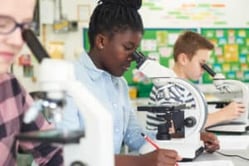Gravity and Mass Inquiry Lab
Middle School Inquiry Lab on Gravity and Mass
In this lab students will test how the size of an object’s mass affects its pull on another object.
Each inquiry lab will contain an essential question that will drive the lesson and make students think. For this lesson, the essential question is:
- How do the masses of objects affect their gravitational attraction?
BACKGROUND INFORMATION AND MATERIALS LIST:
Students will begin the lab by reading the essential question and background information. This can be done individually, as lab groups, or as a whole class. If you consider lab groups, you also might include some type of whole class formative checks before digging into the lab.

Materials List:
- fishing line (10 lb. test)
- 6 small washers (2 cm diameter)
- 4 different hanging masses: 50 g, 100 g, 200 g, 500 g
PROCEDURE:
This lab is divided into two parts. In the first part, students will demonstrate how mass of objects can affect the gravitational pull of surrounding objects. Students will tie fishing line to an anchor point and then thread the line through each washer.
Attaching the other end of the line to a second anchor point, students will add weights to the middle of the fishing line and see what effect the weight has on the position of the washers. Students will record their observations.
In the second part, students will make a scatter-plot graph based on a planet’s mass and the number of moons in orbit around it.
CHECK FOR UNDERSTANDING:
At this point in the lab, students will be checked for understanding by answering questions about their findings. Here are a few that come with the lab:
- What is the effect of the larger masses on the washers?
- How does this model represent the effect of mass and gravity?
- What relationships do you observe between mass and the number of moons from the data above?
- Jupiter is 31,780% the mass of Earth, with 79 moons. Does this fit the relationship you found in the graph? Why?
- If scientists found a new planet with two moons, what might they hypothesize about its mass compared to Earth?
CONCLUSION
Students will go back to the essential question and write a CER (Claim, Evidence, Reasoning) to conclude the lab. Once completed, students will reflect back on their learning by answering the following question:
- If researchers discovered a distant planet with 60 moons, what would that suggest about the planet?
MODIFIED AND INDEPENDENT INQUIRY VERSIONS
All of the Kesler Science inquiry labs come with three different modification levels. Each lab is differentiated using the icons below.
STANDARDS ALIGNMENT
NGSS: MS PS2-4 – Construct and present arguments using evidence to support the claim that gravitational interactions are attractive and depend on the masses of interacting objects.

Download Over $100 in FREE Resources
For Middle School Science
Simply create a login below and gain immediate access to a selection of our Kesler Science product line worth $100 - for FREE. There's a full version of every product type! You'll also join tens of thousands of middle school science teachers who receive timely tips and strategies straight to their inbox.





